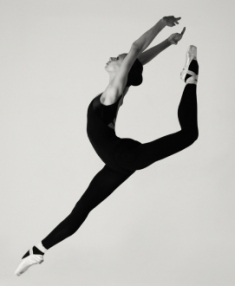
Concert:nova, Cincinnati Ballet in Creative Combo

|
Concert:nova and the Cincinnati Ballet have a good thing going.
During the 2009-2010 season they collaborated on “Carnival of the Animals,” interleaving Saint-Saens’ familiar suite with newly composed works by 15 composers, all with choreography by Heather Britt of the Northern Kentucky University faculty and members of Cincinnati Ballet, performed in Cincinnati Ballet studios downtown.
Wednesday evening (July 6) the same team presented “The Art of the Dance,” a tribute to Martha Graham, comprising Samuel Barber’s “Cave of the Heart” (also known as “Medea”) and Copland’s “Appalachian Spring.” True to concert:nova’s mission not only to be creative, but to present concerts in non-traditional venues, they performed outdoors, in the Alice Bimel Courtyard at the Cincinnati Art Museum.
The 16-member instrumental ensemble, led by guest conductor Edwin Outwater, music director of the Kitchener Waterloo Symphony (Ontario, Canada), performed at the far end of the garden behind a makeshift stage. It made for an acoustical and visual challenge, but for those ideally situated, created an outstanding impression.
Dancers/choreographers Erin Crall, James Cunningham, Stephen Jacobsen, Thomas Caleb Roberts and Maizyalet Velázquez, with Britt as designing choreographer and dancers Courtney Connor, Aaron Hanekamp and Annie Honebrink brought their creative energies to bear on the same music Graham set during the 1940s. It was an entirely new experience, imaginatively conceived and skillfully executed.
The concert opened with “Cave of the Heart.” Premiered in 1946, the ballet is based on the myth of Jason and Medea. Jason was the Greek hero who sought the Golden Fleece. Medea was the wife who aided him in his quest, only to be discarded for another woman and become the archetype of “Hell hath no fury like a woman scorned.” (In the myth, Medea famously wreaks her revenge by killing Jason and their two children).
Ultimately, the ballet is about jealousy, rage and the passions common to humans, and so it was treated here. The nine movements were broken up into highly inventive, but unrelated parts, beginning with an agonized pas de deux by Britt danced by Roberts and Velázquez. There was a tipsy lady in zebra stripes (Connor) executing drunken steps, while balancing, refilling and finally spilling a glass of wine, a pair of guys with towels (Cunningham, and Hanekamp) who clean up after her and a short, sweet solo by Honebrink as a bird, all to choreography by Cunningham.
The movement entitled “Jason’s Solo,” choreographed by Britt, featured Cunningham in spectacular leaps and frolics, easily outdoing his “competition” (Hanekamp) and walking off with the girl (Velázquez). “Medea’s Dance of Vengeance,” the best known excerpt from Barber’s ballet, came closest to mirroring the Greek myth with its vision of zombie-like Erin Crall -- in red nail polish, blood curling from the corner of her mouth – who fights with and kills Jacobsen (choreographer of the segment). There was remorse, however, in Crall’s soft, halting dance afterward, as if she sudden realized what she had done, finally staring at her bloody hands and collapsing on the floor.
“Appalachian Spring,” originally the story of a pioneer couple on their wedding day, was updated to the present. It was a team effort by the six choreographers, Britt also providing continuity. It began with the dancers walking in circles, then pairing off into couples. Two of the young men began a dialogue which turned amorous. The steps were appropriately folkish – to fit Copland’s popular “American” style – combined with theatrical gestures to help get the story across. Jacobsen and Cunningham’s touching duets, Velázquez ‘ outrage at their relationship and Connor’s blessing as the Reverend were all smoothly combined, making for a highly credible scenario.
For those who know “Medea” and “Appalachian Spring” from their popular arrangements for full orchestra, it was a revelation to hear them as originally conceived for small ensemble. Outwater led with great skill and timing and the concert:nova players responded accordingly.
The concert, which closed concert:nova’s fourth season, demonstrated the continued vitality of its mission and its product, which encompasses a wide range of artistic disciplines, from music to dance, film, drama and the spoken word, with a premium on the new and untried. Look for more in the upcoming season.